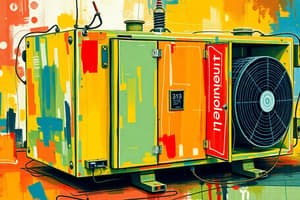Podcast
Questions and Answers
What does the A/D converter do?
What does the A/D converter do?
- Converts analog voltage signal to a digital one (correct)
- Processes the digital signal
- Converts digital signal into an analog signal
- Transmits the analog signal
What is the function of the D/A converter?
What is the function of the D/A converter?
- Changes digital signal into an analog signal (correct)
- Transmits the analog signal
- Converts analog voltage signal to a digital one
- Processes the digital signal
What type of signals does the transducer convert?
What type of signals does the transducer convert?
- Analog signal to a digital one
- Analog signal to a non-electrical signal
- Non-electrical signal to an electrical signal (voltage) (correct)
- Digital signal into an analog signal
How is an analog voltage expressed in binary?
How is an analog voltage expressed in binary?
What does the op-amp do in the context of D/A conversion?
What does the op-amp do in the context of D/A conversion?
What is the primary function of the transducer in the context of A/D and D/A conversion?
What is the primary function of the transducer in the context of A/D and D/A conversion?
In a 3-bit binary system, what voltage does 010 represent?
In a 3-bit binary system, what voltage does 010 represent?
What is the role of the op-amp in the context of D/A conversion?
What is the role of the op-amp in the context of D/A conversion?
What type of signal does the A/D converter convert?
What type of signal does the A/D converter convert?
What are some examples of analog signals mentioned in the text?
What are some examples of analog signals mentioned in the text?
Flashcards are hidden until you start studying
Study Notes
Analog-to-Digital (A/D) Conversion
- The A/D converter converts analog signals into digital signals.
Digital-to-Analog (D/A) Conversion
- The D/A converter converts digital signals into analog signals.
Transducer Function
- The transducer converts physical parameters (e.g., temperature, pressure, sound) into analog electrical signals.
Analog Voltage Expression
- In binary, an analog voltage is expressed as a series of 0s and 1s, with each digit (or bit) representing a specific voltage level.
Op-Amp Function in D/A Conversion
- The op-amp (operational amplifier) amplifies the output voltage of the D/A converter to produce the desired analog signal.
Transducer Primary Function
- The primary function of the transducer is to convert physical parameters into analog electrical signals, which can then be converted into digital signals by an A/D converter.
3-Bit Binary System
- In a 3-bit binary system, the binary code 010 represents a specific voltage level (e.g., 2V, 3V, etc.).
Op-Amp Role in D/A Conversion
- The op-amp plays a crucial role in D/A conversion by amplifying the output voltage of the D/A converter to produce the desired analog signal.
A/D Converter Function
- The A/D converter converts analog signals into digital signals.
Analog Signal Examples
- Examples of analog signals mentioned in the text include temperature, pressure, and sound.
Studying That Suits You
Use AI to generate personalized quizzes and flashcards to suit your learning preferences.




